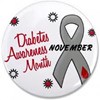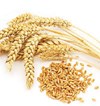Posted 11/2/2013
by Centers for Disease Control and Prevention

In the United States, 26 million are living with diabetes and 79 million more have prediabetes. Now is the time to Take Charge of your diabetes.
Unless we make changes in how we live and eat, forty years from now we may have two or three times as many people with diabetes as we do now. That means somewhere between one out of three and one out of five adults would have diabetes. Right now, about one out of nine adults has diabetes.
Posted 11/2/2013
by The American Journal of Medicine

Research looked at a decade of data from thousands of U.S. adults.
People who don't eat enough fiber seem at increased risk for heart problems, and too few Americans are consuming enough fiber, a new study says.
Posted 10/25/2013
by University of Wisconsin Extension

Gluten-free diets have become popular with some weight-loss dieters and nutrition-conscious consumers. But recent studies show that most dieters who remove gluten from their diet are making these changes without a strong medical reason. “If you have a condition known as celiac disease, it is essential to avoid all foods containing gluten,” says Susan Nitzke, a UW-Madison Professor Emerita and UW-Extension nutrition specialist.
Posted 10/25/2013
by www.womenshealth.gov

You have probably heard the term "calorie" used a lot. When talking about food, a calorie is a unit of energy that the food supplies to your body. But when talking about physical activity, a calorie is a measure of the energy that your body uses in performing the activity.
Calorie balance is like a scale. To remain in balance and maintain your body weight, the calories you get from foods must be balanced by the calories you use in normal body functions and physical activity. If you eat more calories than you use, you gain weight. If you "burn up" more calories than you eat, you lose weight.
Posted 10/19/2013
by www.extension.org

Does dinnertime get you down? Do you spend more time figuring out what to make for a meal than you do enjoying time with your family? Taking the time to plan your meals can save you time, money, and energy.
If the task of planning breakfast, lunch, dinner, and snacks seems too big, start by planning only the evening meal or the largest meal of the day for your family. Once that becomes routine, add in one other meal, and so on. Follow these tips to start your weekly or monthly meal planning routine:
Posted 10/18/2013
by University of Illinois Extension

With Halloween and Thanksgiving just around the corner, the fruits and veggies available in your supermarket's produce department will change.
"There's no need to lament the loss of summer's bounty," said Leia Weston Kedem, a University of Illinois nutrition and wellness educator. "There are many healthy and delicious options in stores during the fall. Pumpkin is one of my favorites."
Pumpkin is packed full of nutrition. One-half cup of canned pumpkin has just 40 calories and is a good source of several nutrients, including dietary fiber and potassium, she said.
Posted 10/11/2013
by www.fightbac.org

As you head out to tailgate before the big game, remember food safety is key to defeat BAC! (foodborne bacteria).
The Play by Play
Posted 10/11/2013
by NDSU Extension Service

They’re flavorful and colorful with names such as Frost, Rain, Xtremo, Fierce, Mountain Blast and Arctic Shatter. What kid wouldn’t want a sports drink during soccer, baseball or hockey practice? Sports drinks are everywhere and are heavily marketed at youth and adolescents.
According to the ads, these drinks not only look and taste good but can improve sports performance while replacing key vitamins and minerals, something we all want for our kids.
But are the ads correct? What isn’t quite so clear in the advertising is the amount of calories in one bottle and what type of performance can be improved.
Posted 10/5/2013
by University of Wisconsin Extension

If you’re cooking for yourself, you may not want to spend much time preparing a meal, says Susan Nitzke, UW-Extension specialist and Professor Emerita in nutritional sciences at the UW-Madison. “But by following a few basic tips, you don’t need to sacrifice good nutrition for speed and convenience when you’re making a meal for yourself.”
Posted 10/5/2013
by www.womenshealth.gov

With all the things that you have to do each day, finding the time and motivation to get moving can be challenging. Here are 20 ideas for getting started and keeping it going:
















